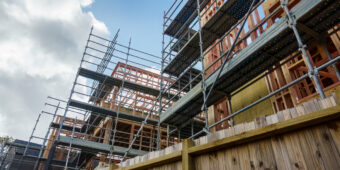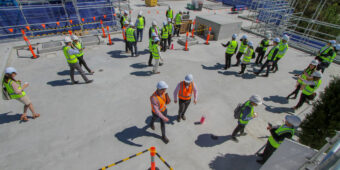HEALTH AND SAFETY BY DESIGN
10 Sep 2019, LBP & Regulation, Learn, Prove Your Know How, Safety, Technical

Your building designs can affect the health and safety of workers constructing, maintaining and demolishing buildings
This is recognised in the Health and Safety at Work Act (HSWA), which was introduced in 2015. It sets out the principles, duties and rights in relation to work health and safety. Although the HSWA focuses on the design of workplaces rather than domestic dwellings, it is important legislation to keep in mind when designing any type of building.
What is health and safety by design?
Health and safety by design is the process of using design to manage health and safety risks throughout the life cycle of a structure, plant, substance or other product. In the context of designing a building, this means considering the health and safety risks throughout the construction, lifetime use, maintenance, and demolition and disposal of a building.
Your power to influence safety
Designers are in a prime position to make buildings, and working on buildings, healthy and safe from the start of the design process. Your decisions will influence the health and safety aspects of a building for its entire lifespan. Making changes at the concept and design phase to improve safety is not only more effective, it can also reduce construction and maintenance costs.
Consider the whole life cycle
For each phase of a building’s life, there will be different hazards for people to consider. It helps to break down the different phases and ask yourself how your design will affect health and safety, and if there are any improvements you can reasonably make, for example:
- Can builders construct your design safely?
Work sites already contain a range of health and safety hazards, and site- or design-specific details can introduce new or unexpected hazards. Consider talking to the building contractor, if possible, about how they plan to construct the building and any hazards they anticipate. You may spot things in your design you didn’t see before, and have the opportunity to make improvements.
- Will the home be safe and healthy to live in?
The Building Code has many features that improve the health and safety of buildings for occupants, such as insulation requirements and barriers on balconies. However, the minimum standards of the Building Code are just that – minimum standards. Are there further improvements you could make?
- Can the building be safely maintained?
For example, are there lightbulbs or other features that require a ladder to access, introducing the hazard of falling from height? Is there another way you could design features to reduce hazards?
- Can the building be safely demolished?
For example, we have stopped using asbestos due to the unacceptable health risk to workers, especially when asbestos is cut, removed or destroyed.
Where to find more guidance
WorkSafe has developed a ‘Health and Safety by Design’ good practice guideline. It includes information on how the HSWA applies to designers, as well as guidance on the principles and considerations of designing with health and safety in mind. The case studies provided mainly focus on infrastructure, however the key principles are transferable to any type of design and can add value to your practice. The guideline can be downloaded for free from worksafe.govt.nz.
This article is an excerpt from Codewords Issue 91. Reading Codewords articles that are relevant to your licence class is a mandatory requirement for Licensed Building Practitioners. These questions can be answered through the LBP portal, online on the Under Construction website or recorded on the magazine, then provided at the time of renewal.
Register to earn LBP Points Sign in
2 Comments
Leave a Reply
You must be logged in to post a comment.




Hazards
done